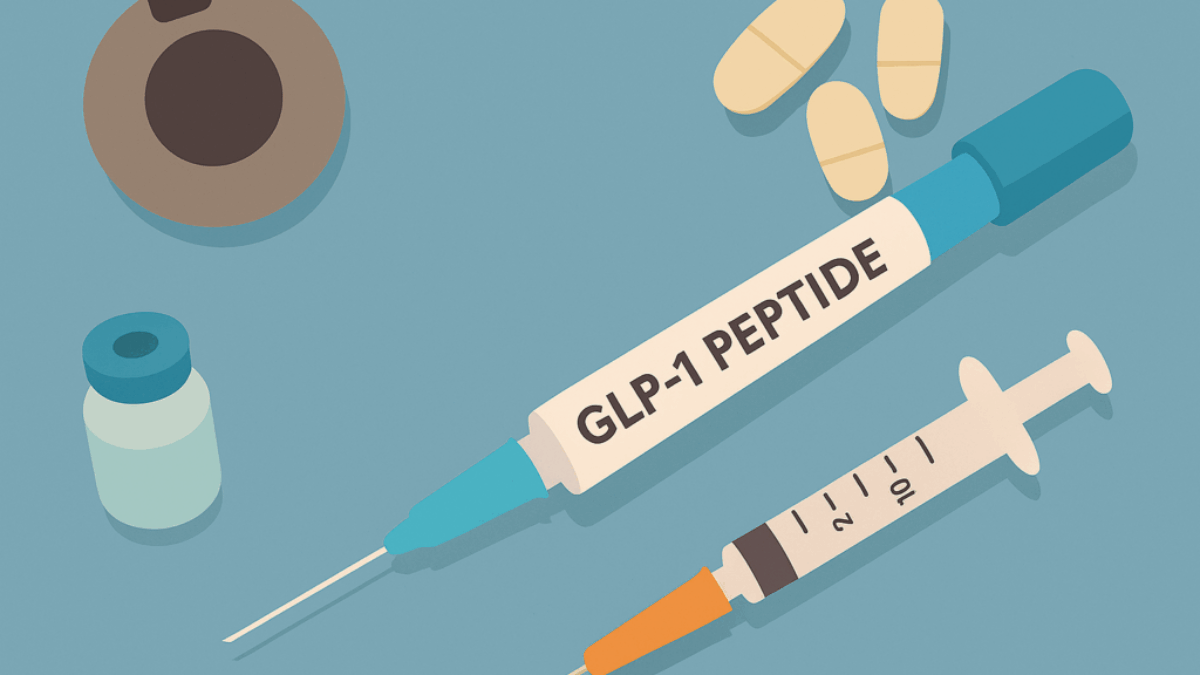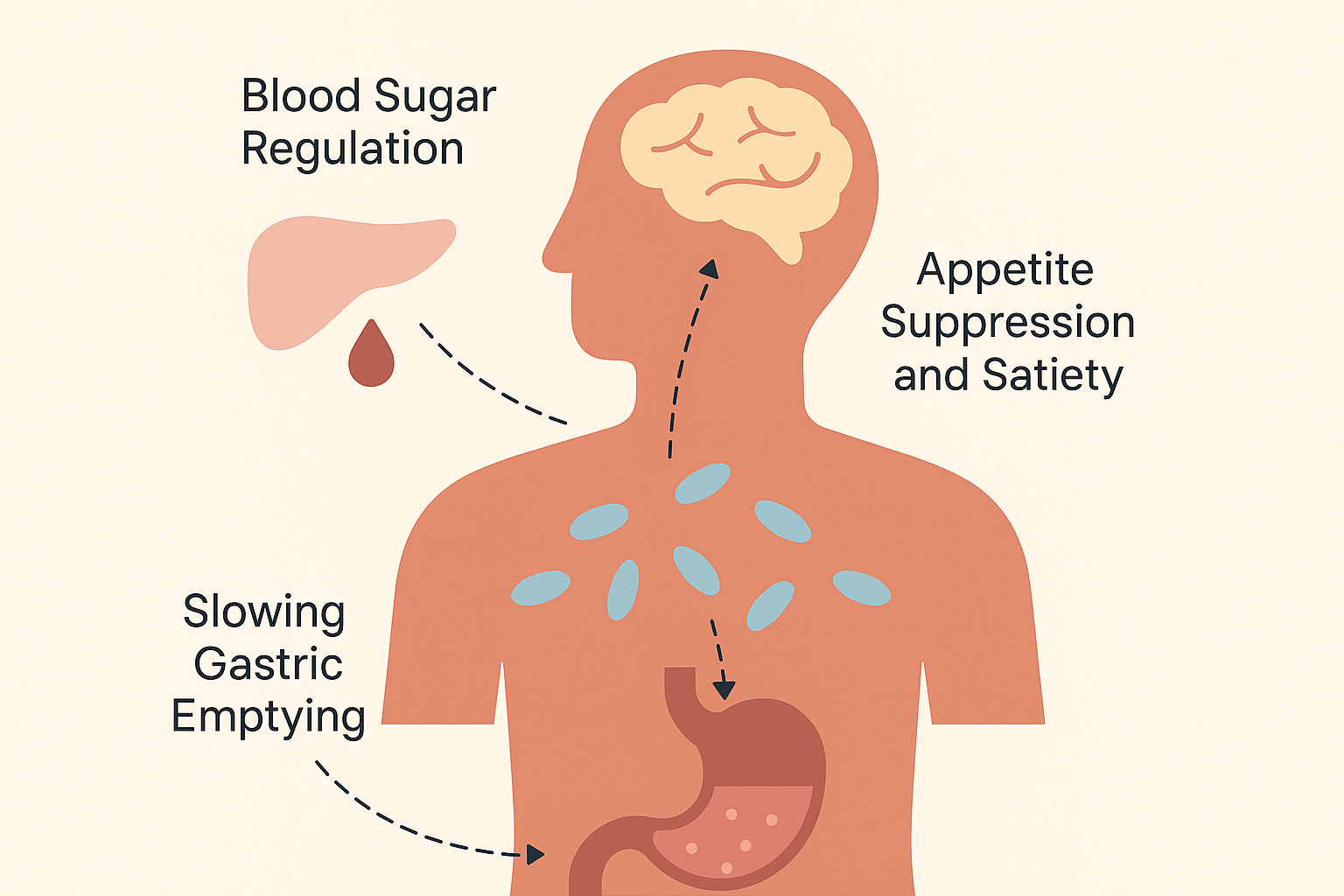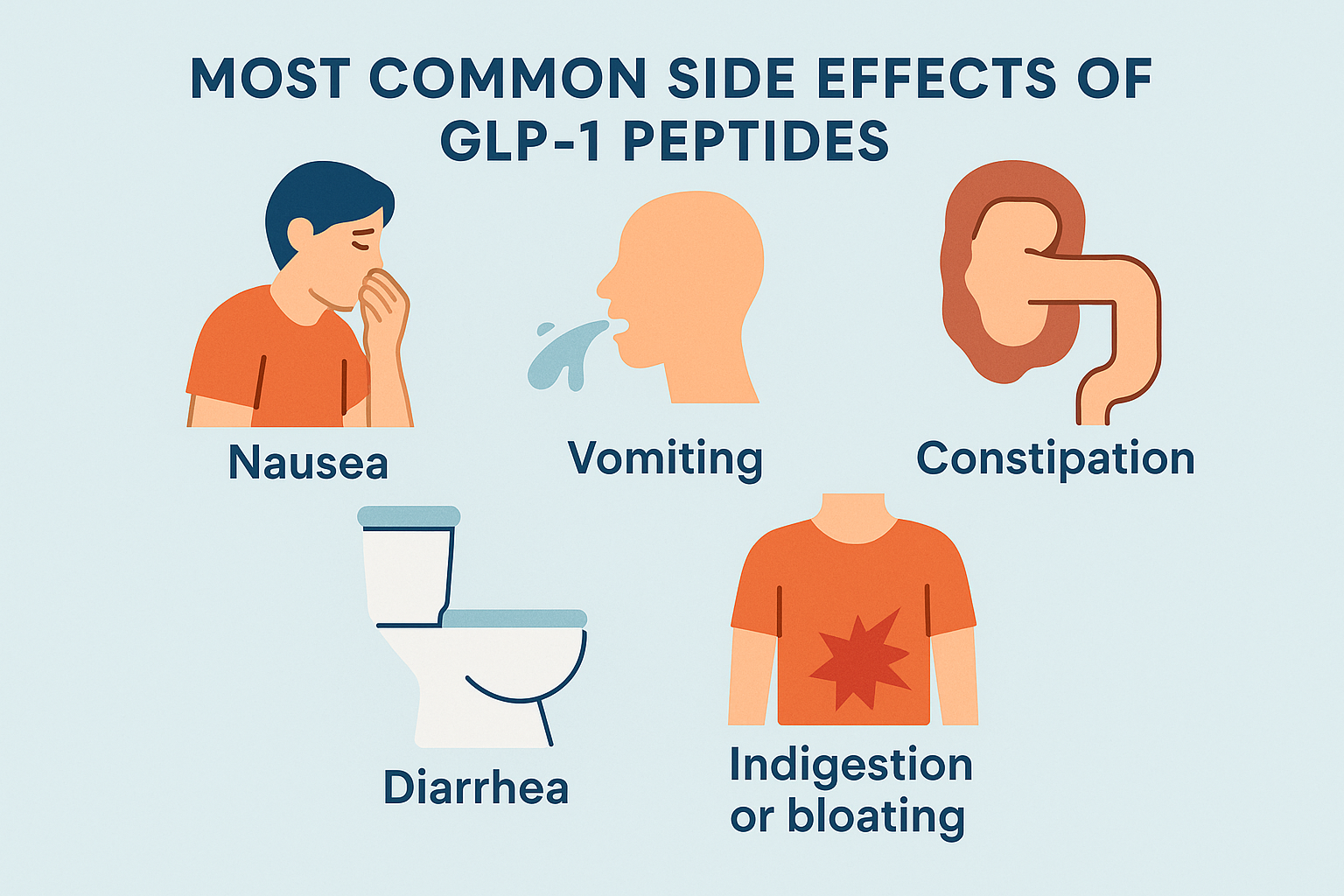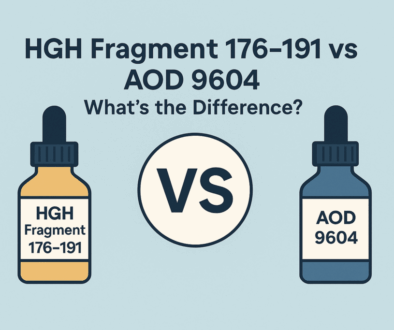The Ultimate Guide to GLP-1 Peptides: What They Are, How They Work, and Why They Matter

Few compounds have sparked as much buzz in health and wellness as GLP-1 peptides. Originally developed to treat type 2 diabetes, these compounds are now gaining widespread attention for their remarkable weight loss benefits.
GLP-1 peptides stand out by taking a multifaceted approach: regulating blood sugar, slowing digestion, curbing cravings, and increasing feelings of fullness. Together, these effects support long-term weight loss and metabolic health.
As a result, GLP-1 therapies like semaglutide and tirzepatide have become a go-to option not just for those with diabetes, but also for people seeking to lose weight.
With more research emerging every month, GLP-1 peptides are poised to become one of the most impactful therapies we’ve ever seen. Here’s everything you need to know about them.
Quick Summary:
- GLP-1 peptides like semaglutide and tirzepatide were first created to treat type 2 diabetes, but they’re now widely used for weight loss and overall metabolic health.
- These compounds lower blood sugar, reduce food cravings, slow digestion, and help you feel full longer—leading to meaningful, sustained weight loss.
- Clinical trials show that GLP-1s can also improve heart health, lower blood pressure, reduce inflammation, and support cholesterol and triglyceride levels.
Table of Contents
What Are GLP-1 Peptides?
GLP-1 stands for Glucagon-Like Peptide-1, a natural hormone made in the gut that plays an important role in managing appetite and blood sugar. GLP-1 peptides like semaglutide and tirzepatide are small chains of amino acids that mimic the actions of GLP-1.
Natural GLP-1: A Gut-Derived Hormone
GLP-1 is part of the incretin family — hormones released by the gut after food intake. In a healthy person, GLP-1 helps:
- Stimulate insulin release from the pancreas (when blood sugar is high)
- Suppress glucagon (a hormone that raises blood sugar)
- Slow gastric emptying, keeping you full longer
- Signal the brain to reduce appetite and food intake
Unfortunately, natural GLP-1 breaks down in the body within just a few minutes, limiting its therapeutic use. That’s where GLP-1 receptor agonists like semaglutide come in.
Synthetic GLP-1 Agonists: Longer-Lasting, More Powerful
Man-made GLP-1 agonists like semaglutide and tirzepatide last much longer in the body. They bind to the same receptors as natural GLP-1 but provide extended and amplified effects.
Some are injected daily (like liraglutide), while others last an entire week with just a single dose (like semaglutide and dulaglutide). Some peptides are also becoming available in oral (pill) form.
Join Our Newsletter — Get 15% Off
Get the latest offers, peptide research insights, and stock updates.
Not All GLP-1 Peptides Are the Same
While they all work through the same basic pathway, GLP-1 agonists can differ in:
- Half-life (how long they stay active)
- Potency (how strongly they affect appetite and glucose control)
- Side effect profile
- Formulation (injection vs. oral options)
These differences can affect which peptide is best for a specific person, depending on their health goals and lifestyle.
How GLP-1 Peptides Work in the Body
GLP-1 peptides help regulate metabolism, blood sugar, and appetite through multiple pathways. Here’s a breakdown of how they work:
A. Blood Sugar Regulation
GLP-1 peptides stimulate insulin secretion only when blood glucose levels are elevated, which helps prevent hypoglycemia (low blood sugar). At the same time, they suppress the release of glucagon, a hormone that normally raises blood sugar levels. Together, these effects help:
- Lower post-meal glucose spikes
- Improve overall glycemic control
- Reduce insulin resistance over time
B. Appetite Suppression and Satiety
GLP-1 agonists act on the brain’s appetite control centers, particularly in the hypothalamus. This leads to:
- A reduced desire to eat
- A feeling of fullness after smaller meals
- Less frequent cravings
- Reduced “food noise”
As a result, people tend to eat fewer calories naturally, leading to weight loss without needing to follow a strict diet.
C. Slowing Gastric Emptying
GLP-1 peptides slow down how quickly food leaves the stomach. This has a few key benefits:
- Prolongs the feeling of fullness
- Reduces the speed of glucose absorption, preventing blood sugar spikes
- May indirectly support gut-brain signaling related to hunger and satiety
D. Cardiovascular and Other Metabolic Benefits
GLP-1 receptor agonists may also:
- Reduce inflammation
- Lower blood pressure and improve lipid profiles
- Improve markers of cardiovascular health
- Support kidney function in people with diabetes
These systemic benefits make GLP-1 agonists a promising class of drugs not only for managing blood sugar and weight but also for improving long-term health outcomes.

Medical Uses and Approved Applications of GLP-1 Peptides
GLP-1 receptor agonists have become a cornerstone in modern metabolic medicine, with growing applications beyond their original use in type 2 diabetes. Here’s a breakdown of their approved and potential future uses:
Type 2 Diabetes Treatment
GLP-1 receptor agonists help regulate blood glucose through multiple mechanisms:
- Enhancing glucose-dependent insulin secretion: These peptides increase insulin release from the pancreas, but only when blood sugar is elevated, reducing the risk of hypoglycemia.
- Suppressing glucagon: GLP-1s inhibit the secretion of glucagon, a hormone that raises blood sugar, especially after meals.
- Delaying gastric emptying: This slows carbohydrate absorption, resulting in a more gradual rise in blood glucose.
These effects make GLP-1 agonists particularly effective for individuals with type 2 diabetes who struggle with post-meal glucose spikes and insulin resistance.
Obesity and Weight Loss
GLP-1 receptor agonists, particularly semaglutide and tirzepatide, are approved for the treatment of obesity in non-diabetic individuals.
- Appetite suppression: By acting on the hypothalamus, GLP-1s reduce hunger and enhance satiety, leading to fewer calories consumed.
- Sustained weight loss: Clinical trials have shown that semaglutide can result in 10–15% body weight reduction, far surpassing most other pharmaceutical options. Tirzepatide has shown even better results (upwards of 22.5% weight loss).
These medications are especially helpful for those with obesity-related complications like metabolic syndrome, hypertension, or sleep apnea.
Cardiovascular Benefits
Several large-scale clinical trials (like LEADER, SUSTAIN-6, and REWIND) have demonstrated cardiovascular benefits in patients taking GLP-1 receptor agonists.
- Reduced blood pressure: Modest decreases in systolic blood pressure have been observed.
- Improved lipid profiles: Some peptides may reduce LDL cholesterol and triglycerides.
- Lower risk of major cardiovascular events: In patients with pre-existing heart disease, GLP-1s have been shown to reduce the risk of heart attack, stroke, and cardiovascular death.
Because of this, certain GLP-1 medications are now indicated for use in type 2 diabetics with high cardiovascular risk, regardless of A1C levels.
Emerging Uses
Potential use in PCOS, NAFLD, and neurodegenerative diseases:
- Polycystic Ovary Syndrome (PCOS): Early studies suggest GLP-1 agonists can improve insulin sensitivity, promote weight loss, and reduce androgens in women with PCOS.
- Non-alcoholic Fatty Liver Disease (NAFLD): By promoting fat loss and improving insulin sensitivity, GLP-1s may reduce liver fat content and inflammation, offering a potential treatment for NAFLD and NASH.
- Neurodegenerative diseases: There is growing interest in GLP-1 receptor agonists as neuroprotective agents in conditions like Alzheimer’s and Parkinson’s disease. The mechanism is believed to involve reduced inflammation, enhanced neuronal survival, and improved mitochondrial function.
- Reducing alcohol intake: Early research and anecdotal reports from users suggest that GLP-1 peptides may reduce alcohol consumption, helping people quit drinking.
While these emerging uses are not yet approved, several clinical trials are underway and could broaden the therapeutic scope of GLP-1 peptides in the near future.
Popular GLP-1 Peptides Comparison Table
Semaglutide and tirzepatide are by far the most popular GLP-1 peptides. However, more GLP-1s are being developed and tested in clinical studies, with retatrutide being the most promising candidate.
| Name | Primary Use | Estimated Weight Loss | Administration |
| Semaglutide | Type 2 diabetes & obesity | ~14.9% at 68 weeks (STEP 1 trial) | Weekly subcutaneous injection |
| Tirzepatide | Type 2 diabetes & obesity (GLP-1/GIP) | 15.0–20.9% at 72 weeks (SURMOUNT-1 trial) | Weekly subcutaneous injection |
| Retatrutide | Obesity (GLP-1/GIP/glucagon triple agonist) | ~24.2% at 48 weeks (Phase 2); up to ~30% in some trials | Weekly subcutaneous injection |
| Mazdutide | Type 2 diabetes & obesity (GLP-1/glucagon) | ~11.3% at 24 weeks (6 mg dose, Phase 2) | Weekly subcutaneous injection |
| Cagrilintide | Obesity (amylin analogue) | 6.0–10.8% at 26 weeks alone; ~20.4% in combo with semaglutide | Weekly subcutaneous injection |
| Liraglutide | Type 2 diabetes & obesity | ~8.0% at 56 weeks (SCALE trial) | Daily subcutaneous injection |
| Dulaglutide | Type 2 diabetes | ~3.0–4.6% at 52 weeks (AWARD trials) | Weekly subcutaneous injection |
Semaglutide and tirzepatide are currently the most popular options for weight loss and type 2 diabetes. Liraglutide remains a reliable daily option, approved for weight loss under the Saxenda brand. Dulaglutide is effective for type 2 diabetes but not currently approved for weight loss.
Meanwhile, retatrutide, mazdutide, and cagrilintide are currently undergoing clinical trials, with retatrutide showing the greatest weight loss benefits and cagrilintide being studied as a combination treatment with semaglutide (CagriSema).
Notably, new-generation GLP-1 drugs work on more than just GLP, making them more effective and less prone to side effects.
Benefits of GLP-1 Peptides
GLP-1 receptor agonists are best known for their weight loss and anti-diabetic benefits:
Blood Sugar Regulation
GLP-1 peptides help stabilize blood glucose levels by enhancing insulin secretion in response to food intake, slowing gastric emptying, and reducing glucagon release. This results in better post-meal blood sugar control and improved long-term glycemic outcomes for individuals with type 2 diabetes.
Significant Weight Loss Potential
One of the most widely recognized benefits of GLP-1 peptides is their ability to support substantial weight loss. Clinical trials have consistently shown average reductions of 10–20% of body weight over time, making them one of the most effective options available.
Reduced Cravings and Improved Satiety
These peptides act on appetite-regulating centers in the brain, particularly the hypothalamus. This leads to a decrease in hunger and food cravings, while increasing feelings of fullness after meals. For many users, this translates into easier calorie reduction without the usual feelings of deprivation.
Cardiometabolic Health Improvements
Beyond weight and blood sugar, GLP-1 peptides have demonstrated cardiovascular benefits, including reductions in blood pressure, improvements in cholesterol profiles, and lower inflammation markers.
Side Effects and Risks

While GLP-1 receptor agonists like semaglutide and tirzepatide offer significant health benefits, they are not without side effects and precautions.
The most common side effect is gastrointestinal discomfort, especially when starting treatment or increasing dosage. Some examples include:
- Nausea
- Vomiting
- Diarrhea
- Constipation
- Indigestion or bloating
One way to reduce these effects is to start with GLP-1 microdoses before gradually increasing them.
Contraindications and Precautions
Although GLP-1s are relatively safe, some people should use them with caution:
- Individuals with a personal or family history of medullary thyroid carcinoma (MTC) or multiple endocrine neoplasia syndrome type 2 (MEN 2)
- People with a history of pancreatitis
- Patients with severe gastrointestinal disease
- Pregnant or breastfeeding women (limited safety data)
- Those taking insulin or sulfonylureas (risk of low blood sugar when combined)
Diet and Lifestyle Tips for Maximizing Results
GLP-1 peptides can significantly aid weight loss and metabolic health, but their benefits are amplified when combined with supportive lifestyle changes such as exercise and healthier eating habits.
Nutritional Strategies to Support GLP-1 Therapy
GLP-1 agonists naturally reduce appetite and slow digestion, making it easier to stick to a healthy eating plan. To enhance their effectiveness:
- Prioritize protein: Helps maintain muscle mass and keeps you full longer.
- Limit ultra-processed foods: These can override satiety signals and promote cravings.
- Eat smaller, balanced meals: Since GLP-1 slows gastric emptying, large meals may cause discomfort.
- Stay hydrated: Water supports digestion and may reduce side effects like constipation.
- Minimize added sugars and refined carbs: Helps maintain stable blood sugar levels.
Exercise Recommendations
Physical activity complements GLP-1 therapy by improving insulin sensitivity, preserving lean mass during weight loss, and supporting mental health.
- Aim for at least 150 minutes of moderate cardio per week (e.g., brisk walking, cycling).
- Include strength training 2–3 times per week to protect muscle and boost metabolism.
- Start small: For beginners or those with mobility challenges, even short daily walks make a difference.
Behavior Change Support for Lasting Success
Medications can help, but long-term success depends on sustainable habits. Consider:
- Meal planning and food journaling to stay mindful of intake.
- Sleep hygiene: Poor sleep disrupts appetite hormones and recovery.
- Stress management: Chronic stress can undermine weight loss and metabolic health.
- Community and accountability: Support groups, coaches, or friends can keep you on track.
When combined with healthy habits, GLP-1 peptides are a powerful tool—not just for weight loss, but for long-term wellness.
Future of GLP-1 Peptides
The field of GLP-1 peptide therapy is evolving rapidly, with new drugs, formulations, and applications expanding their potential well beyond diabetes and weight loss. Here’s what the future holds.
Pipeline Drugs and Next-Gen Therapies
There are many next-generation GLP-1s currently in development or being tested in clinical trials, with the most promising one being retatrutide.
Retatrutide is a triple agonist (GLP-1, GIP, and glucagon receptors) showing even greater weight loss potential and improved metabolic effects than semaglutide and tirzepatide.
These multi-pathway approaches may further enhance fat loss, glucose control, and possibly muscle preservation.
Oral GLP-1 Analogs
Injectable GLP-1 preparations may soon be joined—or replaced—by oral GLP-1 therapies, making treatment more convenient and accessible.
An oral version of semaglutide (Rybelsus) is already available, and other oral peptides are being developed to improve absorption and patient adherence.
Long-Acting and Multi-Action Formulations
Researchers are also working on ultra-long-acting GLP-1 analogs that may require dosing only once a month or even less frequently. These extended-release versions could make it even easier to stick with taking GLP-1s.
Multi-action peptides like retatrutide, that combine GLP-1 with other hormone pathways—such as GIP and glucagon—are expected to become more common.
These can offer broader metabolic benefits, including better lipid control, greater fat burning, and possibly improved lean mass outcomes.
GLP-1 in Longevity and Anti-Aging Research
Emerging research suggests that GLP-1 peptides may have benefits beyond metabolic health:
- Neuroprotection: Studies indicate potential roles in reducing neuroinflammation and protecting against cognitive decline.
- Cardiovascular support: GLP-1s may improve markers of cardiovascular aging and reduce risks of heart disease.
- Cellular health: There’s interest in how GLP-1 signaling may influence pathways related to aging, such as oxidative stress and mitochondrial function.
As research continues, GLP-1 peptides could become a core tool not only for treating metabolic diseases but also for promoting healthy aging and longevity.
Final Thoughts
GLP-1 peptides have rapidly transformed the landscape of metabolic health. Originally developed for type 2 diabetes, they are now widely recognized for their powerful weight loss benefits and could potentially have other uses.
With landmark medications like semaglutide and tirzepatide leading the way, this class of drugs is reshaping how we approach chronic conditions like obesity and insulin resistance.
If you’re considering GLP-1 peptides, take the time to evaluate your goals, health history, and commitment to lifestyle changes.
Frequently Asked Questions (FAQs)
-
Can GLP‑1 peptides be used for prediabetes?
Yes—GLP‑1 agonists like semaglutide and tirzepatide can improve insulin sensitivity and delay progression to type 2 diabetes.
-
Are they safe long-term?
Clinical data support long-term safety, provided patients undergo regular monitoring. Persistent use is common, but ongoing assessment of side effects and metabolism is essential.
-
How soon do results appear?
-
Do you still need diet and exercise?
Ideally, yes. GLP‑1s optimize metabolic control, but their full benefits—especially for weight and cardiometabolic health—depend on maintaining a healthy diet, exercise, sleep, and stress management.
-
What are common side effects?
-
When should you stop treatment?
GLP‑1s are often used long‑term, but if weight is stabilized or side effects occur, tapering off under medical guidance is reasonable. Sudden discontinuation often leads to rebound weight gain.
-
Can GLP-1s be used to reduce alcohol cravings and consumption?
Yes, there’s some early research evidence that GLP-1 peptides can lower alcohol intake and cravings. Some people have also shared their positive experiences online. However, more clinical research is needed before we know more.
References
- Holst, Jens Juul. “The physiology of glucagon-like peptide 1.” Physiological reviews (2007).
- Jastreboff, Ania M., et al. “Tirzepatide once weekly for the treatment of obesity.” New England Journal of Medicine 387.3 (2022): 205-216.
- Gerstein, Hertzel C., et al. “Dulaglutide and cardiovascular outcomes in type 2 diabetes (REWIND): a double-blind, randomised placebo-controlled trial.” The Lancet 394.10193 (2019): 121-130.
- Trujillo, Jennifer. “Safety and tolerability of once‐weekly GLP‐1 receptor agonists in type 2 diabetes.” Journal of clinical pharmacy and therapeutics 45 (2020): 43-60.
- Chavda, Vivek P., et al. “Unlocking longevity with GLP-1: A key to turn back the clock?.” Maturitas (2024): 108028.



